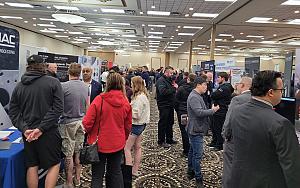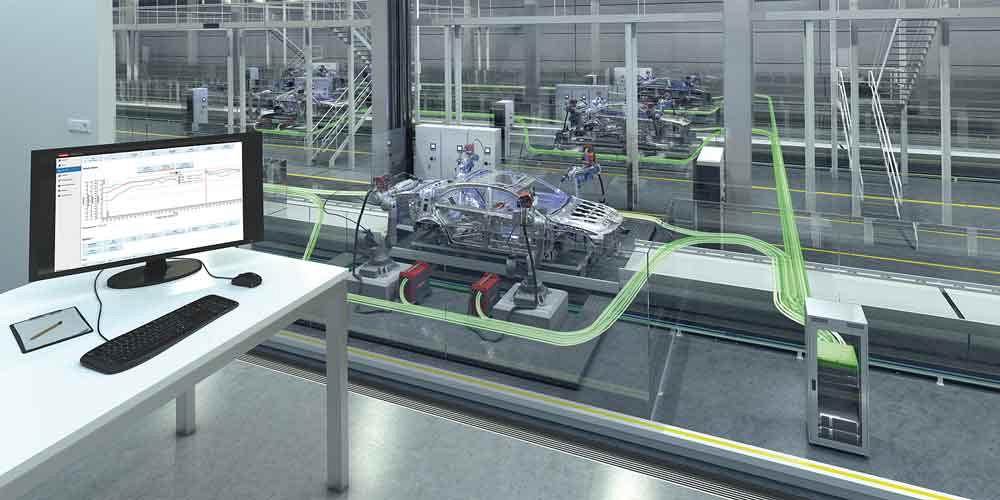Editor
- FMA
- The Fabricator
- FABTECH
- Canadian Metalworking
Industry innovations at EuroBLECH 2016 reflect the need for speed
The world’s largest metal fabricating technology exhibition reveals that faster is better
- By Rob Colman
- December 20, 2016
- Article
- Fabricating

Figure 1. As the power increases on fiber lasers, like Amada’s 9-kW power source on its LCG 3015 AJ laser cutting machine, metal fabricators have to reconsider the adage that fiber lasers are only good for cutting thin sheet metal. These more powerful fiber lasers are cutting plate at faster speeds than previous generations, and they are delivering edge quality that meets most customer specifications.
Visitors to EuroBLECH 2016 in Hanover, Germany, Oct. 25-29, might have thought the show was more about software than metal fabricating machines if they had been looking only at booth graphics and listening to sales pitches. “Internet of Things” and “Industry 4.0” were plastered everywhere in a game of buzzword graffiti, and everyone was talking about machine connectivity and information connectivity between all aspects of a shop and even the supply chain.
Despite the buzz, the message was clear to fabricators: With the right machine tool technology and interconnectivity with shop management systems, metal fabricator operations can squeeze days out of the part-concept-to-delivery window.
Laser Developments Lead the Way
Among 2-D laser cutting equipment manufacturers, the drive for higher kilowatts continued this year. Amada demonstrated a 9-kW laser (see Figure 1), and Bystronic had a 10-kW machine on the show floor. Polish company Eagle even debuted a 12-kW fiber laser cutting machine, which is targeted primarily at plate fabricators.
Mazak equipped its Optiplex 3015 machine with a direct-diode laser. This technology, first demonstrated on a tube laser at FABTECH® 2015 in Chicago, offers faster cutting speeds than fiber laser power sources, according to company officials. The technology is also said to be slightly more energy-efficient than fiber laser resonators. Mazak officials report that the direct-diode laser technology has proven to be very effective in the processing of aluminum parts.
One of the more interesting premiers on the 2-D laser cutting side of the business was TRUMPF’s TruLaser Center 7030 (see Figure 2). This fully automated manufacturing cell cuts and sorts sheets up to 12 mm thick. It sorts parts by lifting them from the sheet and stacking them on a pallet or, in the case of smaller parts, dropping them into bins below the cutting table. The cutting action on the table is designed in such a way that tipping up of parts does not occur.
Rather than traditional slats on the laser cutting bed, this machine tool has a brush table. To prevent small parts from tipping up, TRUMPF developers invented the SmartGate; two slides that move synchronously with the cutting head. The two slides also can change their distance from each other to create different-sized gaps into which the laser beam is focused. Because of this design, the sheet is securely supported during the cutting process, and small parts measuring up to 160 mm by 160 mm can be simultaneously ejected downward.
According to the company, this new machine involved rethinking many different processes, from the movement of the cutting head and table to allow more precise cuts to sorting capabilities and processing. For example, both suction plates and pins are used in the part-removal process, allowing the sorting of parts as small as a credit card.
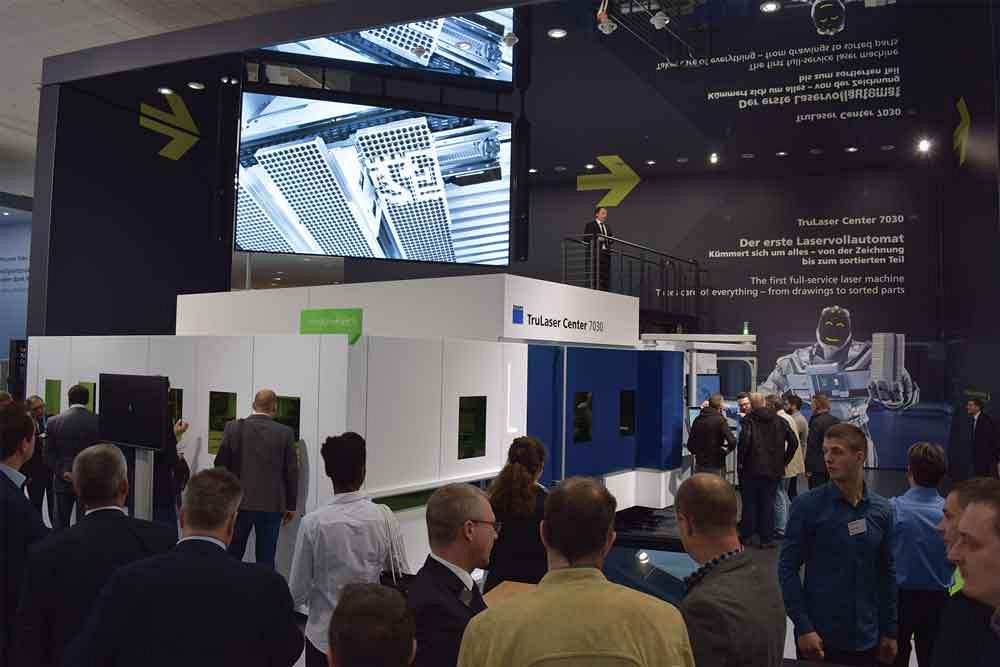
Figure 2. TRUMPF’s TruLaser Center 7030 works with a TruDisk solid-state laser and with 6 kW of laser power. Developers spent time designing the machine to address waste associated with part collisions during laser cutting that shut the machine down and refinishing parts to remove microtabs and spatter often found on the undersides of components after laser cutting.
Bending Better to Beat the Bottleneck
As Bystronic’s head of business unit markets, Johan Elster noted that this continued drive for increased speeds in lasers has necessitated further automation throughout the manufacturing process. For instance, the possibility of bottlenecks at press brakes on a shop floor becomes much more pronounced with such rapid blank processing by today’s modern laser cutting machines.
Many companies at the show had newly developed tool changers on their press brakes. For instance, SafanDarley premiered its E-Brake 200T 4100 ATC, a servo-electric brake with an automatic tool changer, a 200-ton pressing force, and a working length of 4,100 mm. The tool changer is integrated into the machine frame, resulting in a footprint no bigger than the company’s standard electric brake. Bystronic and TRUMPF also demonstrated brakes with automatic tool changers.
Bystronic had another innovative concept involving robotic bending: a mobile bending robot (see Figure 3). At the show, the robot was attached to the company’s small Xpert 40 press brake. This robot can be brought into service to handle repetitive bending jobs, and when such jobs are not in production, it can be pulled away from the brake. The unit then can be operated manually.
Being able to react quickly and flexibly to manufacturing needs is just as important as relying on modern press brakes to bend parts quickly. Time is of the essence. To assist metal fabricators looking to obtain specialty tooling in an expedited manner, Wila introduced its Tool Advisor at the show. This online tool allows operators to make decisions about which press brake tools are best-suited to their specific bending needs. If the required tool is unavailable as part of standard inventory, the fabricator can use the web interface to design a special tool and order it online during the same Internet session.
LVD’s Synchro-Form technology (see Figure 4) stood out as a twist on automated bending looking to alter a niche bending application: the fabrication of long, cylindrical parts. This adaptive bending system is designed to maintain angular consistency on large parts with multiple bends. Each bend is automatically measured and compensated for, so that the geometric profile is perfectly formed. The goal of this system is to eliminate manual operations; reduce setup and handling; and ensure consistent bending results in applications like crane boom construction, part fabrication for heavy-duty vehicles, and light pole manufacturing.
The pace of manufacturing keeps increasing, and production technology and software tools are emerging to help metal fabricators keep up (see Figure 5). This is a universal trend affecting manufacturers all over the world. That’s why many of these equipment debuts will find their way to North America in the coming months, not years.
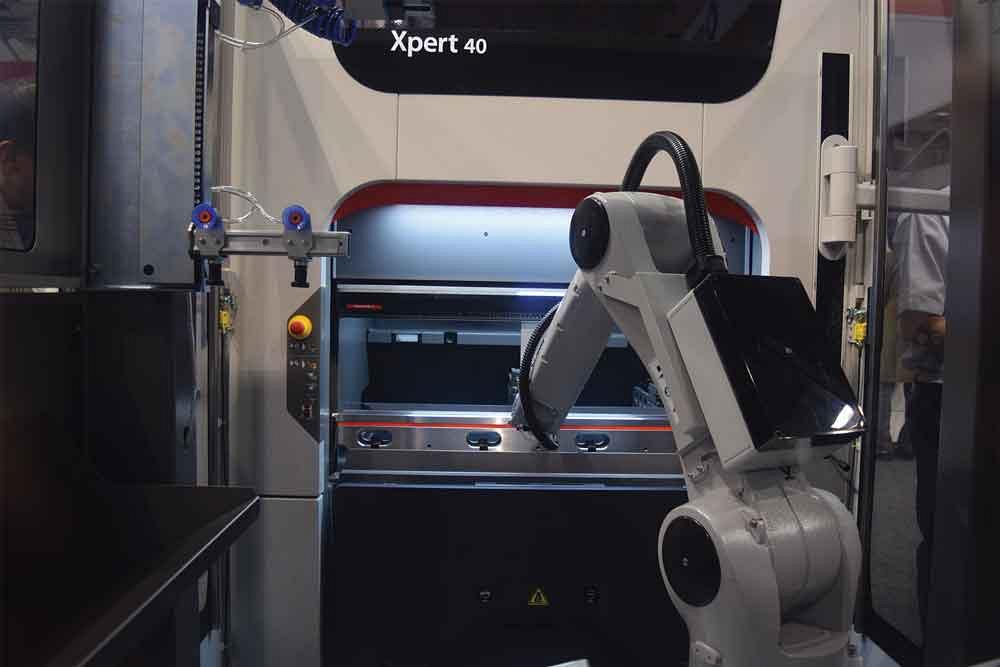
A robot is placed in front of an Xpert 40 press brake from Bystronic to demonstrate the flexibility of the bending cell. After a large, repetitive bending job is done, the robot can be moved, and the press brake can be used for manual operations.
Those North American fabricators that always want to be on the cutting edge and have a desire to see new technology developments before their nearby competitors do might want to consider joining their 60,000 industry colleagues in attending the next EuroBLECH in 2018.
Rob Colman is editor of Canadian Fabricating & Welding and can be reached at rcolman@canadianfabweld.com.
Amada America Inc., www.amada.com/america
Bystronic Inc., www.bystronicusa.com
Eagle Group, www.eagle-group.eu/en
LVD Strippit, www.lvdgroup.com
Mazak Optonics Corp., www.mazakoptonics.com
SafanDarley, www.safandarley.com
TRUMPF Inc., www.us.trumpf.com
Wila USA, www.wilausa.com
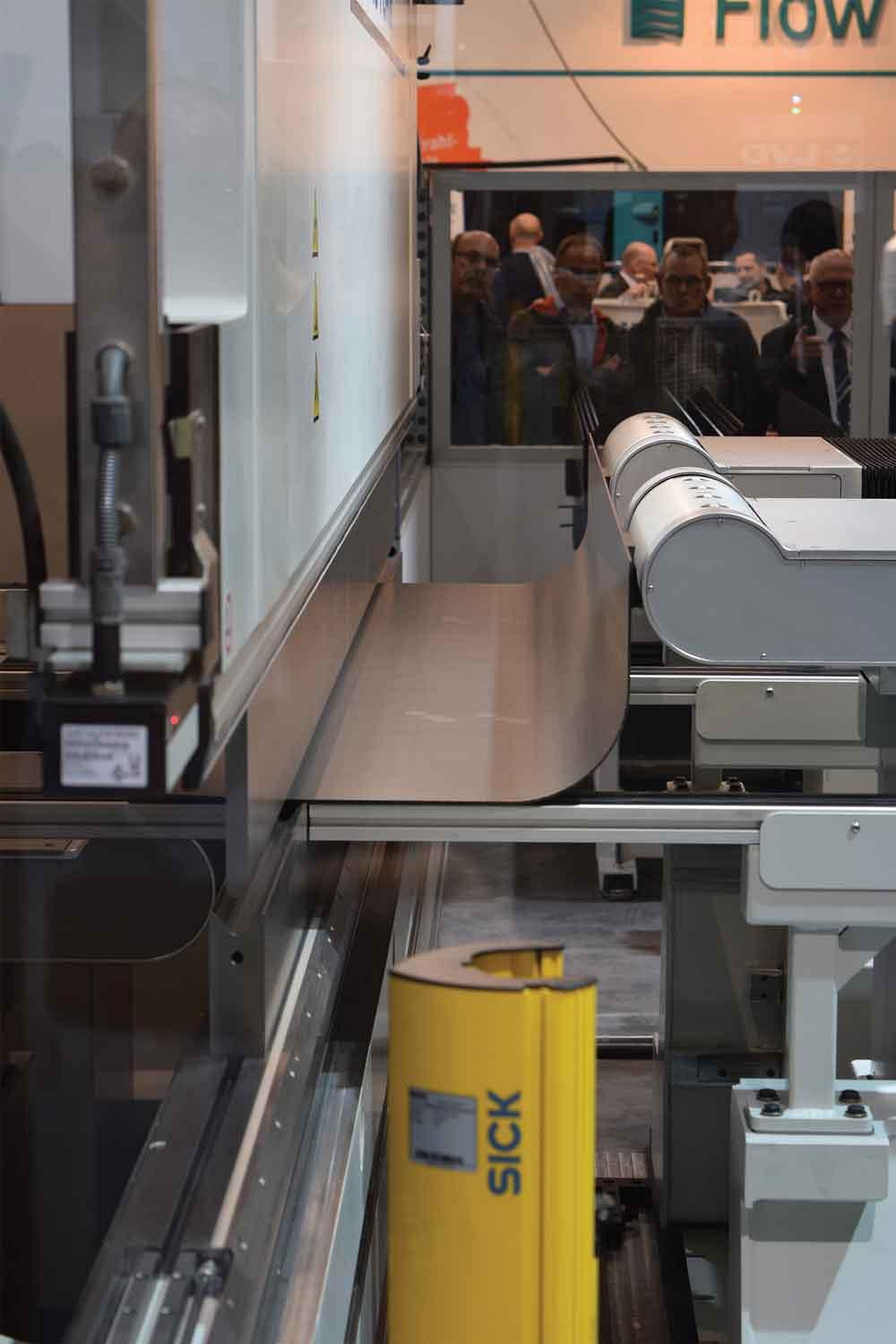
The LVD Synchro-Form technology introduces adaptive bending to large-sized fabrications, such as light poles. The brake checks and adapts successive bump bends to ensure that the right angle has been achieved.
Welders, press operators offered more data for improved output
Data transfer between machines is certainly an important part of what is changing the manufacturing landscape. For instance, the amount of information that can now be communicated from a programmer directly to machines on a shop floor is remarkable.
Welders and press operators aren’t being left behind in this data-rich development, either. At EuroBLECH, both Fronius and ESAB demonstrated their latest documentation and analysis software. This type of software is making it possible to more accurately review how welding machines are being used on a shop floor.
For instance, Fronius’ WeldCube allows you to document and evaluate a range of data, including current, voltage, wire speed, welding speed and time, arc, and dynamic correction or job numbers. The numbers generated can be accessed from any computer or mobile device via a web browser. Up to 50 power sources can be connected on the network, so a sizable shop using the company’s equipment can benefit. The software is compatible with all digital Fronius series, the DeltaSpot® resistance spot welding machine, and the TPS/i platform.
The WeldCube software includes a variety of analysis tools for troubleshooting. Because the analysis is continuous, the company believes it will help prevent production downtime and reduce operating costs.
ESAB’s WeldCloud online data management platform appears to have similar capabilities and goals. It works with ESAB’s Aristo® Mig semi-automatic, Aristo Mig 5000iR robotic, and LAF/TAF submerged arc welding systems. Users can purchase these machines WeldCloud-ready, and ESAB can retrofit most existing systems with a communication module.
The platform can integrate with other systems (ERP, MDM, MRP, QA, etc.).
A few of the things shops can do with WeldCloud include:
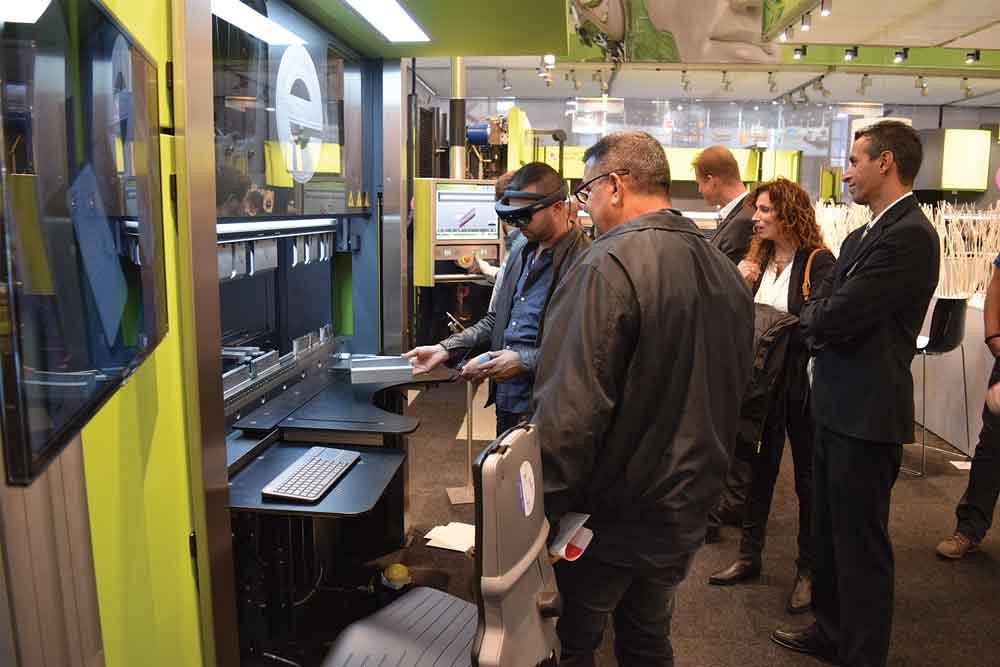
Figure 5. Wearing virtual reality glasses from Microsoft, a show attendee views just how the metal blank should be oriented as he moves it against the bac gauge of the SafanDarley electric brake. Could this be the future of fabricating?
• Develop weld schedules on a single machine, move them into the cloud, and then push them out to other welding machines.
• Remotely manage welding parameters, set limits, and set alarms for deviations.
• Ensure complete documentation of filler metals, consumables, operator qualifications, and parameters.
• Monitor and act upon various productivity reports across operations in disparate locations.
• Share and analyze data by teams across multiple data collection sites, using any computer, tablet, or smartphone connected to the same internal network as the welding systems and database.
Meanwhile, Schuler introduced its Machine Monitoring System (MMS) at the show. The company said that the MMS provides new insights into presses. “With the aid of comprehensive system monitoring, availability can be increased, production and parts quality can be improved, and energy consumption can be lowered,” the company stated in a press release. The MMS is part of the Smart Press Shop, a collection of Schuler products for networking in the field of forming technology.
An integral part of the MMS is the intelligent diagnostics, which automatically archives and evaluates physical variables and control states when specific events occur. This makes rapid fault analysis possible.
The state-monitoring function monitors the system at regular intervals for damage and wear, using torque curves and structure-borne noise analyses, for example. With this state-based maintenance, Schuler believes that components will need to be replaced only when they have actually reached the end of their life, and not just because they have been in operation for a specific amount of time.
For process monitoring, the software creates a permanent log of parameters such as press force and vibration progression that makes possible a cycle-accurate response in real time, when necessary.
The production data acquired includes all planned and unplanned downtimes, including their causes, fault messages, target/actual production, and part quality. In this way, the system operators get an overview of the production status and calculate overall equipment efficiency (OEE).
The concern with any data-gathering device is how it gets used. This will be key for those adopting such data software – determining how best to roll them out and effectively use the information without being overwhelmed by the possibilities offered.
About the Author

Rob Colman
1154 Warden Avenue
Toronto, M1R 0A1 Canada
905-235-0471
Robert Colman has worked as a writer and editor for more than 25 years, covering the needs of a variety of trades. He has been dedicated to the metalworking industry for the past 13 years, serving as editor for Metalworking Production & Purchasing (MP&P) and, since January 2016, the editor of Canadian Fabricating & Welding. He graduated with a B.A. degree from McGill University and a Master’s degree from UBC.
subscribe now


Keep up to date with the latest news, events, and technology for all things metal from our pair of monthly magazines written specifically for Canadian manufacturers!
Start Your Free Subscription- Trending Articles
Class is in session for college connections
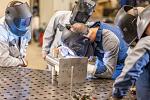
Engine-driven welding machines include integrated air compressors

Compact 2D laser machine designed for smaller shops
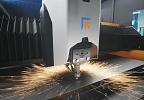
BlueForge Alliance partners with Nuts, Bolts & Thingamajigs to develop Submarine Manufacturing Camps

Orbital tube welding webinar to be held April 23

- Industry Events
ZEISS Quality Innovation Days 2024
- April 15 - 19, 2024
Tube 2024
- April 15 - 19, 2024
- Düsseldorf, Germany
Lincoln Electric's Large Format 3D Metal Printing Seminar
- April 16 - 17, 2024
- Cleveland, OH
CTMA Economic Uncertainty: Helping You Navigate Windsor Seminar
- April 30, 2024
- Windsor, ON Canada
MME Winnipeg
- April 30, 2024
- Winnipeg, ON Canada











